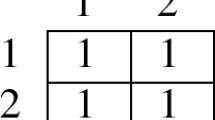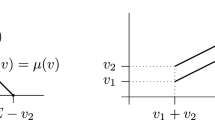Abstract
Young’s theorem implies that every core concept violates monotonicity. In this paper, we investigate when such a violation of monotonicity by a given core concept is justified. We introduce a new monotonicity property for core concepts. We pose several open questions for this new property. The open questions arise because the most important core concepts (the nucleolus and the per capita nucleolus) do not satisfy the property even in the class of convex games.
Similar content being viewed by others
Notes
See Shapley (1953). In this paper we denote by \(Sh(v)\) the Shapley value of a game \((N,v).\)
We define the property for core concepts.
Other definitions may be considered. For example:
A violation of monotonicity by \(\phi \) with respect to games \(v\) and \(w\) is justified if there exists a nonempty set of monotonic transformations of \(v\) , \(A(v)\subseteq \Gamma _{0}\backslash \left\{ v,w\right\} ,\) such that:
-
1.
There exist monotonic core concepts in \(A(v)\cup \left\{ v\right\} .\)
-
2.
There does not exist monotonic core concept in \(A(v)\cup \left\{ v,w\right\} \).
-
1.
To be precise this paper deals with the class of non negative veto balanced games. Non negativity implies that the worth of any coalition is non negative. Therefore, in this section, by \(\Gamma _{VB}\) we refer to the class of non negative veto balanced games.
Not necessarily games with a large core.
Let \(N=\left\{ 1,2,3\right\} \) and consider the following 3-person veto balanced games:
$$\begin{aligned} v(S)&= \left\{ \begin{array}{cc} 4&\text{ if} S\in \left\{ \left\{ 1,2,3\right\} ,\left\{ 1,2\right\} ,\left\{ 1,3\right\} \right\} \\ 0&\text{ otherwise} \end{array} \right. \text{ and} \\ w(S)&= \left\{ \begin{array}{cc} v(S)&\text{ if} S\ne N \\ 6&\text{ if} S=N. \end{array} \right. \end{aligned}$$Any egalitaran concept selects \((4,0,0)\) in game \(v\) and \((2,2,2)\) in game \( w.\)
Zhou (1991) shows that the nucleolus satisfies 1-monotonicity. Our approach is different and we show that any violation of 2-monotonicity is not justified.
In case that \(f_{l2}(y,v)\ge f_{l1}(y,v)\ge 0\) the bilateral transfer is from player \(l\) to player \(1.\)
For example, consider the following case. Let \(N=\left\{ 1,2,3,4\right\} \) be a set of players and consider the following two games:
$$\begin{aligned} v(S)&= \left\{ \begin{array}{cc} 2&\text{ if} \left| S\right| =2 \text{ and} S\notin \left\{ \left\{ 1,2\right\} ,\left\{ 3,4\right\} \right\} \\ 4&\text{ if} S=N \\ 0&\text{ otherwise} \end{array} \right. \text{ and} \\ w(S)&= \left\{ \begin{array}{cc} 2&\text{ if} S=\left\{ 1,2\right\} \\ v(S)&\text{ otherwise.} \end{array} \right. \end{aligned}$$Consider the allocation \((0,0,2,2).\) Only simultaneous transfers from player \(3\) and \(4\) to players \(1\) and \(2\) allow the construction of allocation \( (1,1,1,1).\)
References
Arin J, Feltkamp V (2005) Monotonicity properties of the nucleolus on the domain of veto balanced games. TOP 13(2):331–342
Arin J, Feltkamp V (2012) Coalitional games: monotonicity and core. Eur J Oper Res 16:208–213
Arin J, Kuipers J, Vermeulen D (2003) Some characterizations of egalitarian solutions on classes of TU games. Math Soc Sci 46:327–345
Calleja P, Rafels C, Tijs S (2009) The aggregate-monotonic core. Games Econ Behav 66:742–748
Grotte J (1970) Computation of and observations on the nucleolus, the normalised nucleolus and the central games. PhD thesis, Cornell University, Ithaca
Hoffmann M, Sudholter P (2007) The Shapley value of exact assignment games. Int J Game Theory 35:557–568
Hokari T (2000) The nucleolus is not aggregate-monotonic on the domain of convex games. Int J Game Theory 29:133–137
Housman D, Clark L (1998) Core and monotonic allocations methods. Int J Game Theory 27:611–616
Meggido N (1974) On the monotonicity of the bargaining set, the kernel and the nucleolus of a game. SIAM J Appl Math 27:355–358
Schmeidler D (1969) The nucleolus of a characteristic function game. SIAM J Appl Math 17:1163–1170
Shapley LS (1953) A Value for n-Person games in contributions to the game theory. In: Kuhn HW, Tucker AW, Dresher M (eds) Contributions to the theory of games, vol II. Princeton University Press, Princeton
Sharkey WW (1982) Cooperative games with large core. Int J Game Theory 11:175–182
Tauman Y, Zapechelnyuk A (2010) On non-monotonicity of cooperative solutions. Int J Game Theory 39:171–175
Young HP (1985) Monotonic solutions of cooperative games. Int J Game Theory 14:65–72
Zhou L (1991) A weak monotonicity property of the nucleolus. Int J Game Theory 19:407–411
Acknowledgments
J. Arin acknowledges the support of the Spanish Ministerio de Ciencia e Innovació n under projects SEJ2006-05455 and ECO2009-11213, co-funded by ERDF, and by Basque Government funding for Grupo Consolidado GIC07/146-IT-377-07. We thank an Associated Editor and two anonymous reviewers for their very helpful comments and suggestions. The final version of the paper benefits very much from them.
Author information
Authors and Affiliations
Corresponding author
Rights and permissions
About this article
Cite this article
Arin, J. Monotonic core solutions: beyond Young’s theorem. Int J Game Theory 42, 325–337 (2013). https://doi.org/10.1007/s00182-013-0368-8
Accepted:
Published:
Issue Date:
DOI: https://doi.org/10.1007/s00182-013-0368-8




